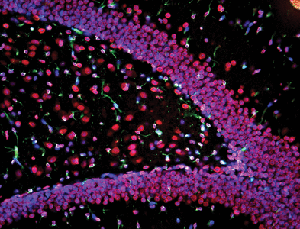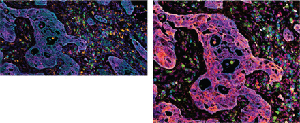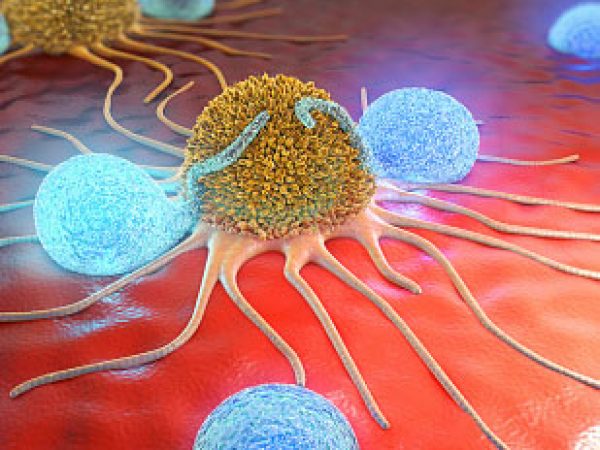Editors’ Picks: December Highlights from AACR Journals
We’re closing out 2021 on the blog with Editors’ Picks, our monthly staple featuring articles handpicked by the editors of the AACR journals. This month’s highlights include an analysis of COVID-19 vaccines in patients with cancer, identification of immunotherapy-responsive pancreatic cancer subgroups, and results from a phase I clinical trial evaluating a novel inhibitor of the transforming growth factor beta receptor, among others. As always, featured articles are freely available online for a limited time.
Best wishes for the new year—we’ll see you in 2022 for continued coverage of the latest in cancer research.
Journal: Cancer Epidemiology, Biomarkers and Prevention
Previous studies have shown that the relative proportions of circulating immune cells correlate with pancreatic cancer prognosis—namely that low levels of CD8+ T cells and high levels of regulatory T cells are associated with poor outcomes. The authors of this study wanted to determine if immune cell proportions in blood derived from healthy individuals could reliably predict pancreatic cancer risk. They used a previously developed DNA methylation-based assay to determine relative counts of CD8+ T cells, CD4+ T cells, regulatory T cells, and neutrophils in white blood cell lysates from 530 patients who eventually developed pancreatic cancer and 533 controls from the European Prospective Investigation into Cancer and Nutrition (EPIC) cohort. They did not find a significant correlation between pancreatic cancer risk and counts of any of the immune cells assayed. However, when the analysis was limited to patients who developed pancreatic cancer within five years of providing their blood sample, individuals with higher levels of FOXP3+ regulatory T cells or lower levels of CD8+ T cells had an increased risk of pancreatic cancer. The researchers propose that, since these correlations disappear with increased time to diagnosis, they may represent a shifting immune landscape in response to a developing tumor, rather than an element of risk. This study was highlighted in the December issue.
Journal: Molecular Cancer Therapeutics
Protein arginine methyltransferase 5 (PRMT5) utilizes methylation to regulate proteins involved in various cellular processes, including splicing, signaling, gene expression, and cellular proliferation. Dysregulation of PRMT5 leads to clinical features associated with cancer. The authors of this study sought to understand how PRMT5 inhibition would impact the growth of PRMT5-mutated cancers. They developed the small molecule JNJ-64619178, which they found to be a potent, selective, and long-lasting inhibitor of PRMT5 activity in cancer cell lines representing lung, breast, pancreatic, and hematologic malignancies. In addition, JNJ-64619178 led to tumor growth suppression and regression in xenograft mouse models. The authors conclude that JNJ-64619178 is a potent and selective PRMT5 inhibitor with potential clinical relevance. JNJ-64619178 is currently being evaluated in patients with tumors driven by aberrant PRMT5 activity. The article was highlighted and featured on the cover of the December issue.
Journal: Cancer Research (December 15 issue)
Longitudinal SARS-CoV-2 mRNA Vaccine-Induced Humoral Immune Responses in Patients with Cancer
Patients with cancer are vulnerable to SARS-CoV-2 infection and subsequent complications from COVID-19. Recent studies suggested that patients with hematologic malignancies and those receiving certain cancer treatments may have limited antibody responses following vaccination with either the BNT16b2 (developed by Pfizer-BioNTech) or the mRNA-1273 (developed by Moderna and the National Institutes of Health) mRNA vaccine. While healthy individuals maintain robust vaccine-induced antibody responses up to six months post-vaccination and have a lower risk of serious breakthrough infections, the longevity of antibody responses and the incidence of breakthrough infections in patients undergoing cancer therapy remain unclear. Here, the authors report results from a prospective study of 366 patients with cancer, 291 of whom were vaccinated against SARS-CoV-2. They found that antibody responses at peak response and after four to six months were significantly higher in patients who received the mRNA-1273 vaccine compared with BNT16b2. Compared with patients with hematologic malignancies, those with solid tumors had higher and more sustained antibody levels post-vaccination. Patients who had undergone prior treatment with B cell-targeted therapy or immune checkpoint inhibitors had lower and less sustained antibody levels compared with those who received these treatments after vaccination. Two vaccinated patients and one unvaccinated patient experienced severe COVID-19. The authors conclude that patients with cancer exhibit diverse antibody responses and longevity, which may be dependent on the type and timing of their cancer therapy.
Journal: Clinical Cancer Research (December 15 issue)
Transforming growth factor beta (TGFβ) is involved in various cellular processes, such as cell growth, differentiation, and migration. During late stages of cancer, TGFβ promotes tumor progression by suppressing antitumor immune responses and by enhancing epithelial-mesenchymal transition, angiogenesis, invasion, and metastasis. Preclinical studies have suggested that inhibiting the TGFβ receptor, alone or in combination with other cancer therapies, may be effective against cancers. Here, the authors report results from a phase I clinical trial that evaluated the safety and efficacy of the TGFβ receptor inhibitor LY3200882 in patients with advanced solid cancers. Patients received treatment with LY3200882 alone or in combination with immune checkpoint inhibition, chemotherapy, and/or radiation therapy. Among the 139 patients who received treatment, 93.5 percent experienced at least one treatment-emergent adverse event (TEAE). Grade 3 TEAEs attributable to LY3200882 were observed only in patients receiving combination therapy. Among 40 patients with grade 4 glioma, partial responses were observed in three patients receiving LY3200882 monotherapy and one patient receiving LY3200882 plus immune checkpoint inhibition. Out of 12 treatment-naïve patients with pancreatic cancer, six had a partial response and three had stable disease in response to combination treatment with LY3200882 and the chemotherapeutics gemcitabine and nab-paclitaxel. The authors conclude that LY3200882 was well tolerated as monotherapy or combination therapy, and that it had preliminary clinical activity in patients with pancreatic cancer. This article was highlighted in the December 15th issue.
Journal: Cancer Research (December 1 issue)

The standard of care for glioblastoma (GBM) is surgical resection followed by radiation therapy. However, after an initial response, the disease tends to recur and be more invasive. Since radiation therapy induces cellular senescence in the tumor microenvironment, in this study the authors dissected the role of senescence in GBM recurrence in mouse models. They observed that cranial irradiation induced widespread senescence of the astrocytes, one of the most abundant cell types in the brain, and that senescent astrocytes had an increased expression of the senescence marker p21 and multiple genes of the senescence-associated secretory phenotype (SASP), which in turn promoted tumor cell migration and growth. Furthermore, tumor cells implanted in pre-irradiated mouse brains had enhanced growth and invasiveness, an effect that was not present in mice lacking the p21 gene. One of the SASP factors, HGF, produced by irradiated astrocytes promoted the migration of GBM cells in vitro, which could be blocked by HGF-neutralizing antibodies or treatment with crizotinib, an inhibitor of the HGF receptor Met. Navitoclax, a senolytic drug that can specifically kill senescent cells and cross the blood-brain barrier, selectively killed senescent astrocytes and slowed down the growth of tumor cells implanted in pre-irradiated brains. This study highlighted the potential of senolytic therapy in preventing GBM recurrence after radiation therapy. This article is featured on the cover of the December 1 issue.
Journal: Blood Cancer Discovery
Overcoming Acquired Epigenetic Resistance to BTK Inhibitors
Growth of the activated B cell (ABC) subtype of diffuse large B-cell lymphoma (DLBCL) is driven by chronically active B-cell receptor signaling, which leads to activation of Bruton’s tyrosine kinase (BTK) and upregulation of the pro-survival NFκB pathway. Three BTK inhibitors, including ibrutinib (Imbruvica), are approved for the treatment of certain leukemias and lymphomas, but in clinical trials of ABC DLBCL, many patients have rapidly developed resistance. While mutations of BTK and its downstream effectors have been identified as one resistance mechanism, in this study, the researchers identified a mutation-independent epigenetic resistance mechanism, driven by increased activity of the transcription factor TCF4. Of the genes differentially regulated by TCF4 in ibrutinib-resistant ABC DLBCL cells, resistant cells were especially dependent upon RAC2, which the researchers found could bypass BTK to activate the NFκB pathway. A high-throughput drug screen revealed several drugs with increased efficacy in ibrutinib-resistant cells as compared to parental cells, including a RAC1/RAC2 inhibitor. The researchers showed that a similar inhibitor, EHT1864, decreased growth of ibrutinib-resistant cells in culture, as in mouse xenograft models. The researchers propose that RAC2 could therefore be a promising drug target in patients with ABC DLBCL resistant to BTK inhibitors. A commentary on this study is available here.
Journal: Cancer Immunology Research

Patients with pancreatic cancer often do not respond to immunotherapy, such as antibodies targeting the immune checkpoint proteins PD-1 and PD-L1, necessitating new biomarkers to identify patients who are most likely to respond. The authors of this study sought to characterize pancreatic cancer samples into different subgroups based on the level of PD-L1 expression on tumor cells and surrounding immune cells, and to determine whether there was any correlation with outcomes. They stained 118 microsatellite-stable and five microsatellite-instable pancreatic cancer samples for PD-L1 and immune cell markers using immunofluorescence and validated their findings in an independent cohort of 226 samples using immunohistochemistry. Of the samples expressing PD-L1 (38 in the study cohort and 67 in the validation cohort, all microsatellite-stable), the researchers delineated four patterns: two adaptive subgroups with PD-L1 expressed in immune cells and not expressed in tumor cells (adaptive-1 subtype) or lowly expressed in tumor cells (adaptive-2 subtype); a constitutive subgroup with PD-L1 expressed highly in tumor cells but not in immune cells; and a combined subtype, with high PD-L1 expression in both tumor and immune cells. They found that the constitutive subtype was marked by low immune-cell infiltration and poor outcomes, while the adaptive-1 subtype had high infiltration of cytotoxic T cells and the best outcomes. The authors suggest that the identification of an immunotherapy-responsive subset of pancreatic cancer tumors may help improve precision treatments for this disease. This study was featured on the cover of the December issue.
Journal: Cancer Discovery
The tumor suppressor p53 is the most frequently mutated gene in human cancer, and it is often silenced in a variety of tumor types. Drugs targeting negative regulators of p53, such as MDM2, are currently in clinical development in an attempt to reactivate the tumor suppressor. Recent studies have shown that p53 also plays a role in silencing endogenous retroviral elements (ERVs), repetitive sequences from viral infections along human evolutionary history. Expression of ERVs has been shown to promote inflammation and immune activation and decrease tumor-mediated immune suppression. The authors of this study therefore sought to determine whether p53 reactivation would affect ERV expression and antitumor immune responses. Contrary to their hypothesis, the researchers found that pharmacological p53 reactivation using MDM2 inhibitors stimulated the expression of ERVs in a variety of cancer cell lines. The researchers further showed that this phenomenon occurs via p53-mediated inactivation of the ERV repressors LSD1 and DNMT1. Reactivated p53 also decreased dsRNA degradation, stimulated the sensing of dsDNA by the immune system, and triggered an interferon-mediated viral mimicry response in cancer cells, which resensitized poorly immunogenic tumors to immunotherapy in a mouse model. The authors further showed that the viral mimicry response and tumor inflammation gene expression signatures were triggered in melanoma patients upon treatment with an MDM2 inhibitor. They therefore suggested that pharmacological p53 activation may increase tumor immunogenicity by derepression of ERVs. This study was featured on the cover of the December issue.
Journal: Clinical Cancer Research (December 1 issue)
This study reports the results of a randomized phase II clinical trial that evaluated the safety and efficacy of adding the PARP inhibitor veliparib to second-line chemotherapy in patients with metastatic pancreatic cancer. Current second-line therapy for pancreatic ductal adenocarcinoma after progression on first-line therapies include a combination of folinic acid, fluorouracil, and irinotecan, a regimen called FOLFIRI. The investigators compared FOLFIRI with veliparib plus a modified FOLFIRI regimen (mFOLFIRI) that excluded fluorouracil to improve tolerability. The study was halted after an interim analysis indicated that the veliparib/mFOLFIRI combination was unlikely to improve prognosis (median overall survival was 5.4 months with veliparib and mFOLFIRI and 6.5 months with FOLFIRI alone) but caused more toxicity. However, by testing patients for the presence of mutations that cause DNA damage repair defects, this study indicated that FOLFIRI may improve progression free survival and overall survival in patients with defective homologous recombination repair. According to the authors, further studies would be helpful to establish if this subgroup of patients will benefit from FOLFIRI treatment. This article is highlighted in the December 1st issue.
Journal: Molecular Cancer Research
Small-cell lung cancer (SCLC) is an aggressive lung cancer type of neuroendocrine origin representing approximately 15 percent of all lung cancers and characterized by low survival rates, early metastasis, and resistance to therapy. Unfortunately, little progress has been made in the treatment of this disease. Inactivating mutations of the TP53 and RB1 tumor suppressors are common drivers of SCLC, but different molecular subtypes exist based on the expression of certain key genetic regulators. Since RB1 loss has been associated with increased expression of SOX2, a master regulator of neural and neuroendocrine cell types, the authors of this study used an engineered mouse model to investigate the effects of Sox2 loss on SCLC formation. They observed that SOX2 is critical for SCLC tumor initiation and regulates key SCLC genetic pathways, including those that promote the progression from an ASCL1 subtype to the more aggressive NEUROD1 subtype. According to the authors, understanding this genetic switch is critical to unraveling the molecular mechanisms underlying SCLC progression, heterogeneity, and therapy resistance. This article is highlighted in the December 1 issue.
Journal: Cancer Prevention Research
Transcriptome-wide In Vitro Effects of Aspirin on Patient-derived Normal Colon Organoids
Research indicates that aspirin has chemopreventive benefits on colorectal cancer, but the mechanisms underlying these effects are unclear. According to the authors of this study, human colon organoids provide a more representative model to study the normal colon epithelium and recapitulate its cellular heterogeneity than other preclinical models. They used a large repository of colon organoids established from normal mucosal biopsies to investigate the effects of aspirin treatment on gene transcription. RNA sequencing showed that a three-day aspirin treatment at therapeutic doses resulted in widespread changes in gene expression compared with control treatment. Analysis of the differentially expressed genes revealed that aspirin decreased Wnt signaling, reduced the population of transit-amplifying cells that are produced following proliferation of intestinal stem cells, and inhibited the synthesis of tumor-promoting prostaglandin. The study also identified novel aspirin target genes implicated in colon tumorigenesis.



